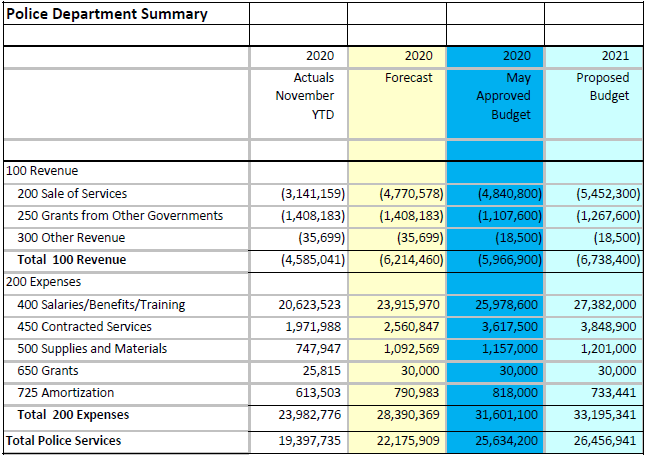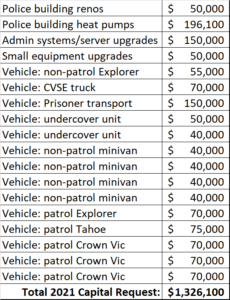Last week we had a Council workshop on the budget. After a couple of previous workshops, and backed up by a pile of reports on different aspects of both the Capital and Operating plans for 2021 and beyond, staff brought us a presentation with an outline of the budget they would like to bring to Council for approval. The basic asks from staff were: do you have the info you need to make this decision, and are there any significant changes you need to see before we ask you to vote on this in a subsequent meeting?
The answers were basically yes and yes.
But I’m not going to go over the budget material again here today. It has shifted a bit since I wrote these Blog posts on the Capital, Utilities, and Operational budget, and there may be some minor adjusting yet, and when the final documents get to Council for approval, I will come back to report on that.
The one part coming out of those discussions that garnered a lot of attention was a motion to freeze the Police operational budget at 2020 levels. In short, the Police budget in 2020 was $31.6 Million and the requested budget for 2021 was $33.3 Million, an increase of $1.73 Million, or about 5.5%. As I have written about in earlier discussions of the Operational budget, some of this is a baked in increase due to inflation and annual wage increases, some of it is “enhancements”, which are new costs related to new programs or changes in how the department operates. It is also a little more complicated because some of these costs (about $650K) are anticipated to be offset by new non-property-tax revenue, as some of the activities the Police Department does are revenue-generating.
The requested “enhancements” for 2021 were pretty modest, $90,000 for a new Temporary Full Time position to hire someone to coordinate the Diversity Equity, Inclusion, and Anti-Racism (“DIEAR”) plan that arose from the recent Police Board Motion on these issues, and $44,000 to pay for increased PPE and Naloxone, which apparently used to be funded by the provincial government, but is no longer. In Council’s discussion of these enhancements, it was questioned whether the DIEAR work should be under the Police budget or the City’s HR budget (as the City is undergoing similar work and the two streams really need to be aligned). No-one opposed the spending on Naloxone, though I may lament that the Province should not be downloading this cost on to local governments.
Again, it is worth reviewing again what I wrote about in the summer. The Police Act makes a clear distinction between the roles of City Council and the Police Board. Council is not meant to oversee the operations of police, but are required to approve a budget for police. The budget is first put together by the Police Board (well, in reality, put together by the police department and approved by the Police Board, much like how City staff put together the City budget and ask Council to approve it) then brought to Council to be included in our budget. As a Council, we have essentially no say in how the Police spend the budget they are provided. Though there is some reporting every year of operational details from Police, and we do have occasional (maybe once a year?) Council-Police Board meetings, from a numbers point of view this is the level of detail that City Council gets when asked to approve a police budget:
We also go through the requests for additions to the Capital budget. The police service Capital budget request for 2021 was this, which mostly represents replacement of heavily used equipment as it approaches end-of-life:
The discussion at Council about these requests was mostly around when the best time to shift the types and number of vehicles we purchase in order to achieve our larger Climate Action goals. Police fleets as they exist are a real trouble spot for de-carbonizing our vehicle operations, as electric or even plug-in Hybrid vehicles essentially don’t exist in North American police fleets (Google low-emissions Police vehicles, and the majority of hits are from the UK, for some strange reason that is taking me way off track here…). In the end, Council voted to support all of the $1.3M in Police Capital requests, so the rest of the conversation here is the about operational budget.
During budget deliberations over the last few weeks, there has been more scrutiny of the Police Budget than I remember in previous years. Of course, this is in context of the larger conversation around North America about policing, about the impacts our model of policing disproportionally has on Black and (in Canada especially) Indigenous people and on populations made vulnerable by the overlapping crises of a poisoned drug supply, a failing mental health system, and increasing economic disparity as we endure a fourth decade of this grand neo-liberalism experiment. I hear the calls for change, and the questioning if the Police are the right organization to be at the front line addressing these crises in our community. The center of those discussions was the idea of shifting resources from policing to other ways to address the community impacts of these crises.
When the motion came forward to freeze the NWPD operation budget at 2020 levels, the motion did not come out of “Left Field”, but was a natural extension of the conversation the community (not just in New Westminster) has been having over the last year, and was written in the undercurrent of our budget deliberations over the last month. During the spirited Council debate on the issue, I was compelled by the strength of the arguments for making this move at this time, and I thank my Council colleagues for that (As always, I don’t want to speak on their behalf, you can watch the video yourself is you want to follow the tenor of the conversations).
If we agree (and I do) that we need a different model to address the impacts of addiction, mental health, and poverty in our community, that the status quo needs to change, then this is one of the few places where we, as a City Council, can force that change. So much of the increases in City budgets in recent years has been finding other ways to help with these problems in our community, even when those things are outside of our jurisdiction – we are spending the money because someone has to. We are helping provide community-based health care in our support of the Umbrella Co-op, we are helping reduce homelessness in supporting the Rent Bank, we are helping reduce the impact of the poisoned drug supply with funding of Naloxone for our fire department and in working with Fraser Health to establish safe consumption sites in the City. So much of the emphasis of our COVID response was in assuring the most vulnerable in our community have access to the supports they need – because we know they are going to feel the impacts of COVID the most. Emergency shelter, food security, seniors outreach, access to washrooms and hygene for unhoused people, the list goes on. As do the demands. This is what we need to fund to be a just and safe community for all.
So when asked “what are you going to do instead”, those are the beginning of the answers. We also need to be holding the new Provincial Government’s feet to the fire about the downloading aspects of expecting local governments to fund these things, and we need to keep pushing for the legislative changes needed to help the most vulnerable in our community. They are moving in the right direction, but it simply isn’t fast enough, and it is not clear to me that they are really committed to spending the money that needs to be spent.
This is hard. This is not a decision made lightly, or for unthoughtful reasons. It is also difficult to have conversations about these issues because so much of the public rhetoric about policing and police reform is polarized and lacking in both civics and civility. But I’m hopeful we can have a respectful and productive conversation between Council, the Police Board, and the Province about where we go from here. The idea that New Westminster could go from having an truly innovative police service (and we do) to having a transformational approach to policing, to even be a “pilot city” for new approaches at a time when the Province is talking about changes to the Police Act, is an opportunity I think we should embrace.